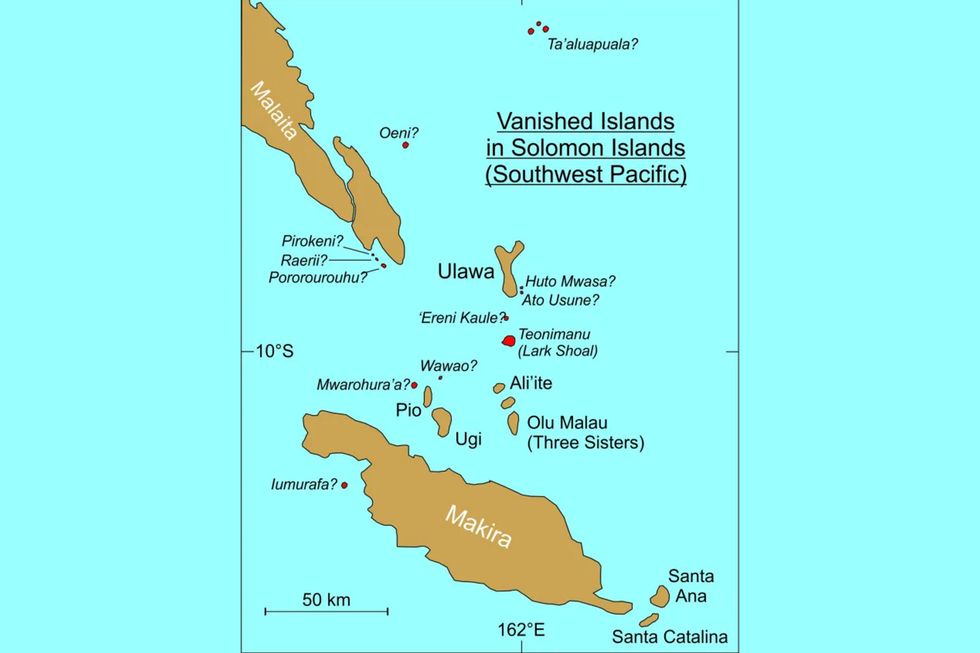Harriet Brewis
May 20, 2024

Teonimanu was home to hundreds of people before it sank beneath the waves
(iStock)
Most of us rely on hard facts and evidence to piece together human history when, really, we owe so much to oral storytelling and myth.
Indeed, whole communities and lands would lie forgotten if it weren’t for the tales our ancestors passed down over the generations.
And now it has emerged that an entire island would have been lost to time had it not been for local legends.
Teonimanu was a landmass that once formed part of the Solomon Islands in the Pacific Ocean and, some 300-500 years ago was home to hundreds of people.
That was, until it disappeared beneath the waves.
This is according to Professor Patrick Nunn, a geologist at Australia’s University of the Sunshine Coast who learnt about the lost land from the people of the central Solomon Islands.
Based on their oral traditions and histories, Nunn believes Teonimanu most likely disappeared sometime between the late 16th century and the late 18th century, as IFL Sciencenotes.
And this wasn’t some gradual subsidence into the sea: when it went down, it went down quickly.
Nunn was told of how only a few of Teonimanu’s inhabitants managed to make it to their canoes in time and reach the safety of the other islands.
The volcanic island was said to have been struck by an enormous wave that submerged it, essentially washing it away.

Nunn who, in 2009, published a book titled ‘Vanished Islands and Hidden Continents of the Pacific,’ pointed out that if it weren’t for the stories told by people who have lived in the region for generations, we would probably never know of the now-drowned island’s existence.
“Their stories might easily be mistaken for legends, for fictions, but like many such ancient stories there remain cores of truth – genuine observations – that over time have become encased in layers of narrative embellishment,” he wrote.
Many of the legends surrounding Teonimanu’s sudden destruction begin with a woman from the island who was called Sauwete'au, IFL Science reports.
She was married to Roraimenu, a man who lived on nearby Ali'te island, but one day fell in love and eloped with another man, called Kaliita’alu, and both returned to Teonimanu.
Furious at the betrayal, Roraimenu cursed the island, unleashing eight devastating waves upon it and climbing to the highest point on Ali'ite from where he could watch its collapse with vengeful satisfaction, so the legend goes.
Of course, we now take such tales of spells and curses with a generous pinch of salt, but that shouldn’t remove from the story’s ultimate truth: that wild forces plunged Teonimanu down into a watery grave.

Lark Shoel, a small landmass which now sits where the island once stood, is located within the Pacific Ring of Fire – a region famed for its tectonic activity.
And now, by analysing seismic data, Nunn believes he has identified debris from that fateful Teonimanu landslide.
The geologist’s main takeaway from this discovery is the significance of oral narratives.
Without stories passed down through the generations by people living in remote and volatile locations, great chunks of our shared history would be lost. And now, as the devastating implications of climate change loom heavy, this is a lesson worth revising.
As Nunn explained to the BBC: “I think everywhere in the world, as oral societies are becoming largely literate, knowledge that has been held orally is disappearing, yet it is this indigenous knowledge that is going to help [future generations] cope with sea level rise.”
Sign up for our free Indy100 weekly newsletter
How to join the indy100's free WhatsApp channel
Have your say in our news democracy. Click the upvote icon at the top of the page to help raise this article through the indy100 rankings
Top 100
The Conversation (0)













